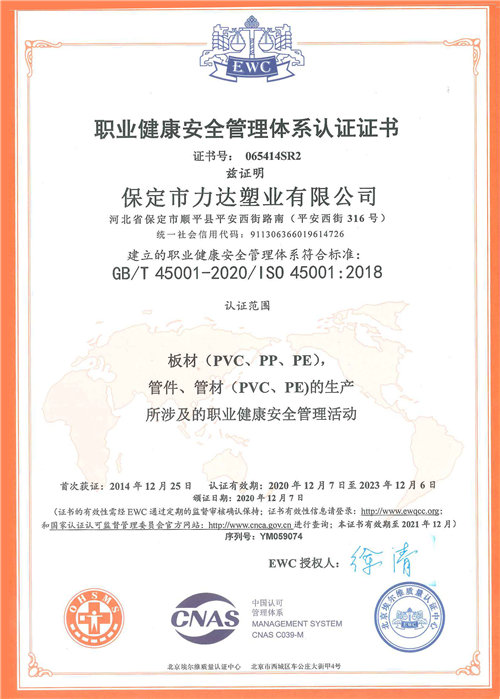نوفمبر . 24, 2024 17:08 Back to list
Exploring the Benefits and Applications of HDPE Tubing in Various Industries
The Versatility and Benefits of HDPE Tubing
High-Density Polyethylene (HDPE) tubing is rapidly becoming a staple in various industries due to its impressive range of properties and applications. Known for its durability, chemical resistance, and versatility, HDPE tubing has found its way into construction, agriculture, water management, and many other fields. In this article, we will explore what HDPE tubing is, its characteristics, and the reasons behind its increasing popularity.
What is HDPE?
HDPE, or High-Density Polyethylene, is a thermoplastic polymer made from the monomer ethylene. This material is characterized by its high strength-to-density ratio, which allows it to be used in a wide array of demanding applications. The manufacturing process involves polymerizing ethylene at high pressures, resulting in a dense and sturdy material. HDPE is often recycled, which contributes to its status as an environmentally friendly option.
Key Characteristics of HDPE Tubing
1. Durability One of the hallmark characteristics of HDPE is its durability. It is resistant to impact and can withstand harsh weather conditions, making it ideal for both indoor and outdoor applications. Its resilience ensures a long service life, reducing the need for frequent replacements and maintenance.
2. Chemical Resistance HDPE has an excellent resistance to a wide range of chemicals, including acids, bases, and solvents. This makes it a preferred choice for industries that handle hazardous materials, as it minimizes the risk of leakage or corrosion.
3. Lightweight Compared to traditional materials like metal or rigid PVC, HDPE tubing is lightweight, making it easier to transport and install. This characteristic not only helps in reducing labor costs but also minimizes transportation emissions associated with heavier materials.
4. Flexibility HDPE tubing is available in various sizes and can be fabricated into different shapes, allowing for customization based on specific needs. Its flexibility enables it to navigate tight spaces in construction and plumbing applications with ease.
5. Cost-Effectiveness The long-lasting nature and low maintenance requirements of HDPE tubing make it a cost-effective solution. By opting for HDPE, businesses can save on both installation and operational costs over the life cycle of the product.
Applications of HDPE Tubing
hdpe tube

The applications of HDPE tubing are broad and varied
- Water Supply and Irrigation HDPE tubing is extensively used in water supply systems for its resistance to corrosion and leakage. It’s widely adopted in agricultural irrigation systems, ensuring efficient water distribution while minimizing waste.
- Construction In construction, HDPE is used for drainage systems, as it efficiently manages wastewater and stormwater. Its flexibility allows it to accommodate changes in terrain without compromising its integrity.
- Electrical Conduit HDPE tubing serves as an electrical conduit, protecting electrical wires from environmental factors and physical damage. Its non-conductive properties make it suitable for this purpose.
- Chemical Handling Industries that handle various chemicals utilize HDPE tubing for transfer lines and storage tanks, ensuring safety and compliance with environmental regulations.
- Pneumatic and Hydraulic Systems The lightweight and flexible nature of HDPE makes it an excellent choice for pneumatic and hydraulic applications, providing a reliable and efficient solution for transporting air and fluids.
Environmental Benefits
Beyond its practical advantages, HDPE tubing also offers environmental benefits. Being 100% recyclable, it helps reduce plastic waste. Furthermore, its long lifespan contributes to less frequent replacements, ultimately leading to lower resource consumption.
Conclusion
In summary, HDPE tubing stands out as a versatile and valuable material across numerous industries. With its combination of durability, chemical resistance, flexibility, and cost-effectiveness, it meets the diverse needs of modern applications. As businesses continue to prioritize sustainable practices, the demand for HDPE tubing is likely to increase, underscoring its role in shaping a more efficient and eco-friendly future. By understanding the advantages and applications of HDPE tubing, industries can make informed choices that benefit both their operations and the environment.
-
Premium CPVC Sheet: High-Temp & Chemical Resistant Solutions
NewsAug.15,2025
-
Durable PPR Pipe for Hot & Cold Water Systems - Easy Install
NewsAug.14,2025
-
Durable HDPE Sheet | Versatile & Impact-Resistant Plastic
NewsAug.13,2025
-
Premium PVC Soft Sheets: Clear, Flexible & Durable
NewsAug.12,2025
-
Premium PVC Round Rods: Durable, Chemical Resistant, Easy to Machine
NewsAug.11,2025
-
PP U-channel: Chemical-Resistant, Lightweight & Durable
NewsAug.10,2025

